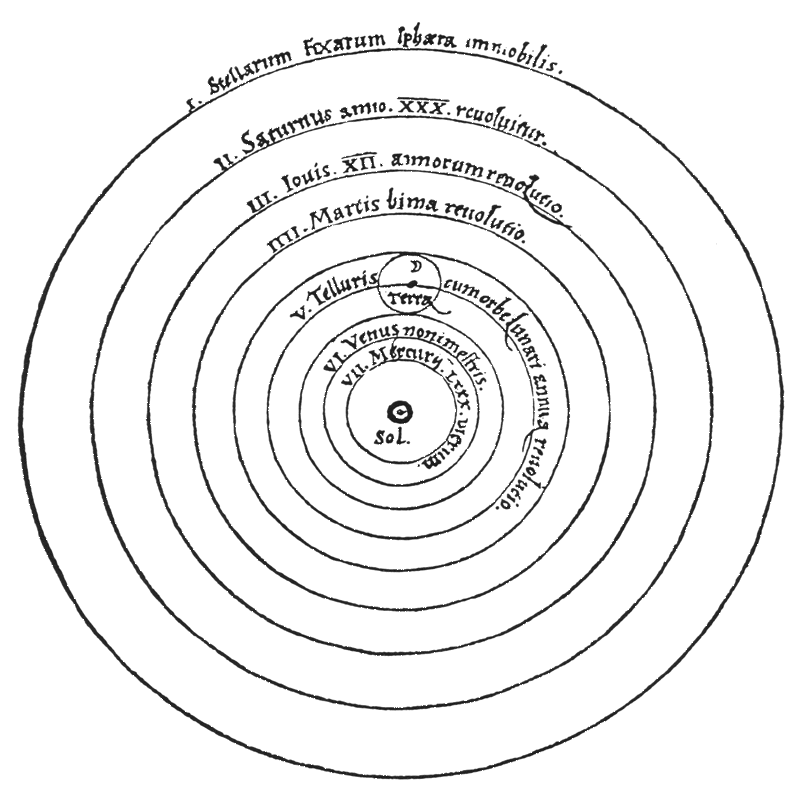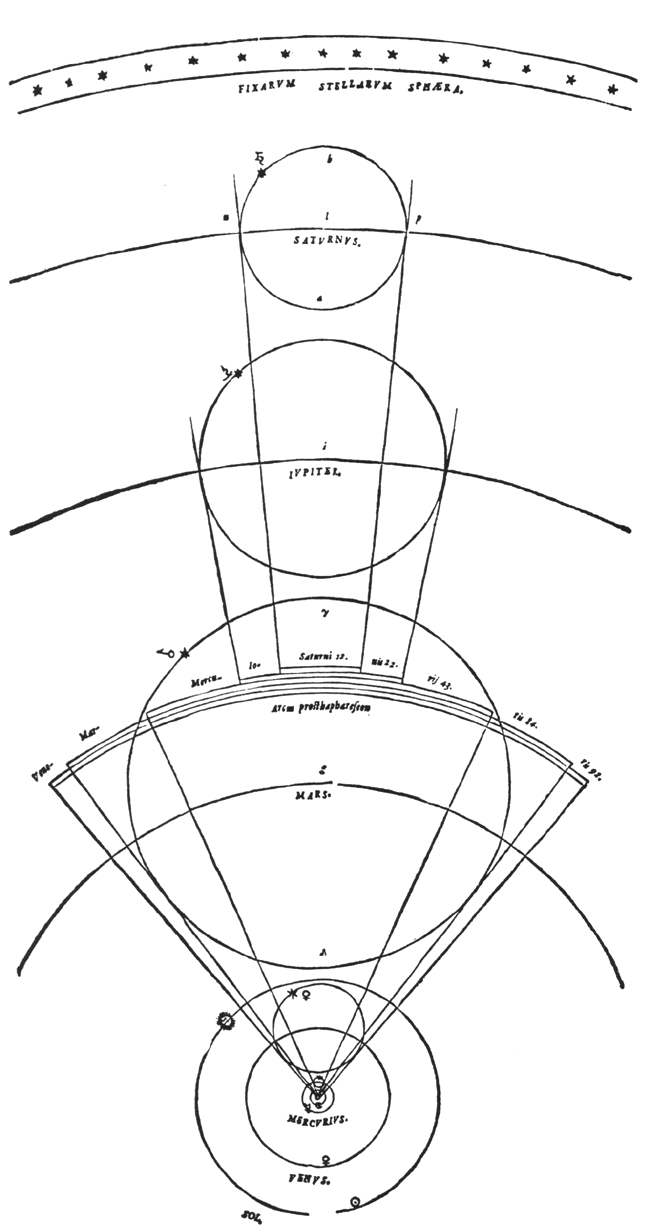

The Solar System
The Copernican conception.
The pre-Copernican conception.
The sun (Sol) is at the center.
The earth is at the center (bottom).
Mercury, Venus, Earth&Moon, Mars,
Mercury, Venus, the Sun, Mars, Jupiter,
Jupiter and Saturn move around it.
and Saturn move around it. The sphere of
the fixed stars is at the top.
For an account of the tumultuous 150 years of discovery that stretch from the publication of Copernicus' "De Revolutionibus Orbium Coelestium" in 1543 to Kepler's "Astronomia Nova" (1609) and "Harmonices Mundi" (1619) to Galileo's "Sidereus Nuntius" (1610) and "Discorsi" (1638) to Newton's "Philosophiae Naturalis Principia Mathematica" of 1687 please read
Alexandre Koyré, From the Closed World to the Infinite Universe. First published in 1957.
Alexandre Koyré, The Astronomical Revolution: Copernicus-Kepler-Borelli.
Scientific American
has a special report, Revolution in Cosmology, in the January 1999
issue.
The December 1999 Special Issue has an article by Martin
Rees, Exploring our Universe and Others.
See also the article The Evolution of Galaxy Clusters
in the December 1998 issue.
Science News of 4-17-99 reports on "he first evidence that a star similar to the sun has a system of planets circling it" (p. 244). Whether or not there are "other worlds out there" is of great importance in the various debates in Galileo. Giordano Bruno, repeatedly mentioned in this context, was burnt at the stake for believing it (Sagredo, Scene 3).
There have been numerous essays on the subject since, both in Science News and Scientific American, to name only two popular journals. Like certain areas of Biology, Astronomy too seems to be stuck in fast-forward.
Marie Boas Hall, The Scientific Renaissance. 1450-1630.
Stephen W. Hawking, A Brief History of Time, has brief biographical sketches of Galileo and the obnoxious Newton.
J. Bronowski & Bruce Mazlish, The Western Intellectual Tradition. Note specifically the chapter "From Leonardo to Galileo".
Daniel J. Boorstin, The Discoverers. The chapter "Seeing the Invisible" is a must here.
People have always craved devices that would enhance their
natural abilities. Eye glasses, telescopes, microscopes, the latter two
inventions made during Galileo's time. (In other contexts, like Faust,
for instance, it appears as resort to magic or enlisting the help of the
devil).
The May 31, 2003 issue of Science
News features an essay on the recent debate whether 15th and 16th century
painters "secretly used mirrors or lenses to project traceable images onto
their canvases" to "achieve the arresting realism of their paintings" 346.
In the same context, Scientific
American has published a special edition called "Science's Vision:
The Mechanics of Sight." 1998. It's a collection of the magazine's own
essays on the subject ranging from 1979-97.
Also Opticks by Isaac Newton (Foreword by Albert Einstein). Dover Publications.
Will & Ariel Durant, The Age of Reason Begins, vol. VII of their Story of Civilization.
Michael J. Crowe, Theories of the World from Antiquity to the Copernican Revolution.
J.L.E. Dryer, A History of Astronomy from Thales to Kepler.
Dialogues Concerning Two New Sciences by Galileo Galilei. Dover Publications.
Dava Sobel, Galileo's Daughter: A Historical Memoir
of Science, Faith, and Love. New York, 1999.
This is the age of doubt, says Brecht's Galileo, the 17th century scientist. "It ain't necessarily so," says Gershwin's Sportin' Life of the 1930ies. "De t'ings dat yo li'ble / to read in de Bible / it ain't necessarily so. / Now I takes dat gospel / whenever it's pos'ble / but wid a grain of salt."
But "doubt" wasn't meant to replace Faith. Just blind faith, unquestioning obedience and mindless superstition. Galileo claims that the Bible is one of his favorite books. So said Brecht when asked ("You'll laugh"). Doubt is merely the "new" method to obtain "truth," replacing Anselm of Canterbury's (1033-1109) much maligned and misunderstood method of seeking understanding through faith: Neque enim quaero intelligere ut credam, sed credo ut intelligam. The patron saint, if one were needed, is the Apostle Thomas who would not rely on the testimony of others but only on his own senses, seeing and touching.
But that too is problematic. Remember Star Wars?
"Don't trust your eyes, they will deceive you," Ben (Obi-Wan) Kenobi instructs
Luke Skywalker.
You can't trust your senses. One of the greatest obstacles
in the way of scientific advance is common sense. I see that the sun rises
in the East and settles in the West, says Andrea. "That isn't seeing,"
Galileo tells the boy, "all you do is stare." Seeing involves the mind.
This is so simple yet radical and revolutionary an insight that even Galileo
himself doesn't quite grasp it. Just look through the telescope, he tells
his colleagues, and trust your eyes. Can they? Should they? On whose authority?
Which brings us back to "faith", or does it? We'll talk about it.
We'll talk about Galileo's recantation (scene 13) and
his own analysis of it (scene 14). Why the quotation on the topic of "scales"
from his Discorsi at the end of 13? There is an article Built
to Scale in the October 16, 1999 issue of Science
News.
Galileo reinvents the Socratic method in order to question, first of all, Aristotelian physics or, more generally, sloppy observations and hasty conclusions. "There's happiness in doubting," says the Little Monk, "I wonder why."
While the new science is subversive because it questions traditional and cherished beliefs, laughter is even more so. That's the significance of the physicists' laughter in Scene Nine, and of Scene Ten, set in the carnival of 1632.
Read or reread in this context Umberto Eco's The
Name of the Rose (1980). The Franciscan William of Baskerville (modeled
after William of Ockham, about 1285-1347) is called to a Benedictine
abbey in northern Italy to solve a series of murders. It turns out that
they were committed by the blind librarian Jorge who is guarding a "subversive"
manuscript,
Aristotle's (384-322 BC) long lost Theory of Comedy.
Jorge hates laughter. "You can't eliminate laughter by eliminating the
book" protests William in a dramatic confrontation. "True," says Jorge,
"but laughter is weakness and corruption, it is base, it loves to desecrate....
And this book elevates laughter to an art, it becomes the object of philosophy
and perfidious theology. When a man laughs at his master he feels superior
to him; laughter frees the sinner from fear of the devil." He's right,
of course. Laughter is subversive. That's the meaning of the "physicists'
laughter" in Scene 9 and of the Carnival Scene following it. It also explains
the therapeutic significance of the political joke in societies under totalitarian
rule, Hitler's Germany, the Soviet Union.
The danger, the old monk believes, is that Unholy Mother
Church in her unwisdom will sanction the text as she did so many others
by "that pagan philosopher," after "that Dominican," meaning Thomas
Aquinas (1224-74), had integrated much of him into christian doctrine.
Unfortunately including, as we shall see, Aristotelian physics.
William, who now holds the text in his hands, reads or
rather translates it aloud, from Greek into Latin. Then fire breaks out
in the library and consumes the entire abbey including the precious manuscript.
The film version, with Sean Connery as William, stages a blaze of burning
books that recalls those of Alexandria, of Don Quixote and
of Germany, 1933. But, fortunately, his young scribe and assistant
Adso was present when William recited it, he writes it down from memory,
and Umberto Eco edits Adso's ancient account. And now we have, twenty-three
centuries after its composition and at long last, Aristotle's text,
or something like it.
Practice your leap of faith.
Then consult
Robert R Provine, Laughter: A Scientific Investigation,
Viking, 2000.
Reviewed by Frans De Wal in Scientific
American. December 2000.